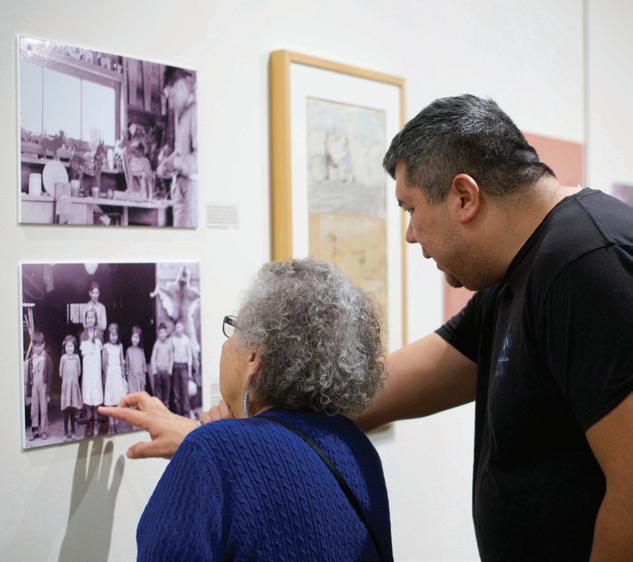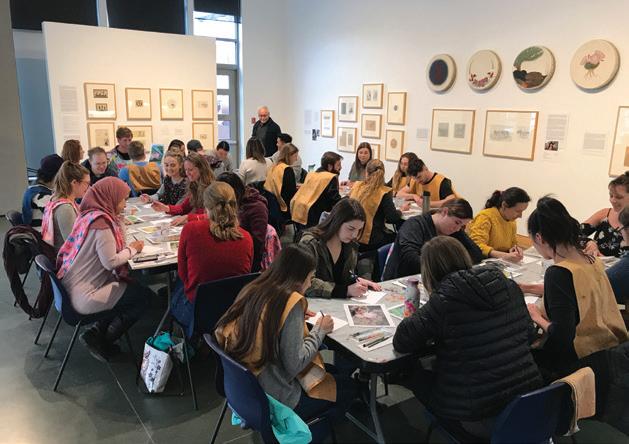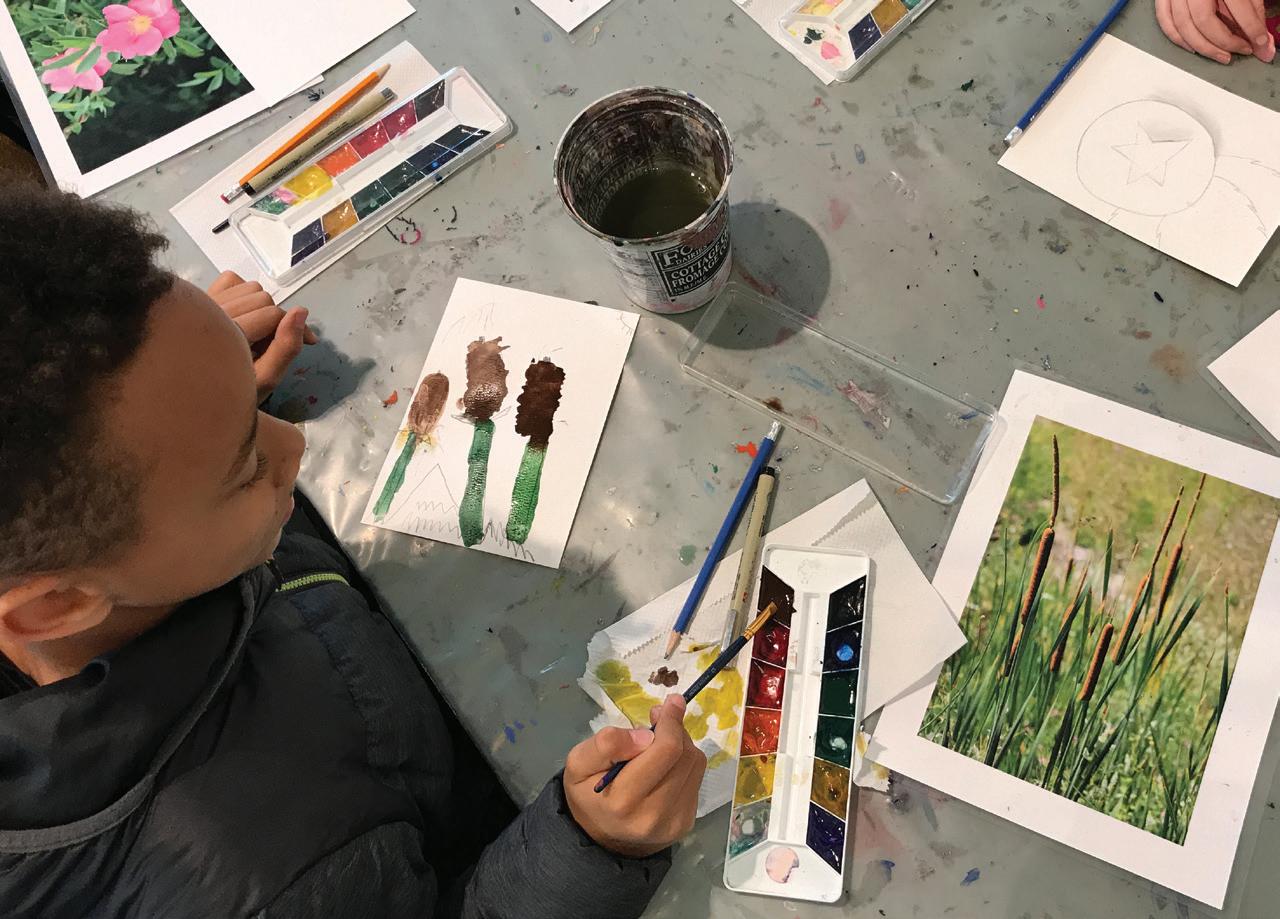
6 minute read
Transformative Engagement & Relationship Building
Our Lives Through Our Eyes: Nk’Mip Children’s Art
Nataley Nagy Executive Director: Kelowna Art Gallery
Advertisement
Laura Wyllie Curator of Learning & Engagement: Kelowna Art Gallery
Jennifer Garner Education & Programming Coordinator: Kelowna Museums

Elder Caroline Baptiste at the opening reception looking closely at some of the pictures of her and her friends when they attended the day school
When introducing this shared exhibition between the Kelowna Art Gallery and the Kelowna Museums Society at the BC Museums Association Conference in Prince George, we felt it was necessary to include the words of guest curator Andrea Walsh, Associate Professor of Anthropology from the University of Victoria. Walsh, who has worked with the elders and families connected to the Nk’Mip Day School for eighteen years, says:
“The story of Nk’Mip Day School between 1932-42 is unique considering the larger context of Indigenous childhood in Canada during the 20th century. The achievements and successes of the syilx children who attended the Nk’Mip school during that time are all the more outstanding considering the ways colonialism and systemic racism contextualized their lives. The syilx students worked together with their teacher, Mr. Anthony Walsh, to create drawings, paintings, stories, and plans that honoured syilx/Okanagan language and culture and documented their everyday lives. The students’ production of art and drama based on their Okanagan identity and history became nationally and internationally renowned.
It is remarkable that the artwork that was displayed in this exhibition survived to tell this important story of Indigenous children’s culture, and talent. The story of the Nk’Mip Day School changed dramatically after Mr. Anthony Walsh resigned from his post as a teacher. His successor turned his attention to a curriculum based on religion and stripped the classroom of the children’s artworks and burned them in a fire, along with the paper mache masks they created for their acclaimed dramatic productions.
Today, the story of the Nk’Mip Day School, its students, their teacher, and the innovative art program, is one that the Osoyoos Indian Band tells proudly as a part of their artistic and cultural heritage. The Osoyoos Indian Band has highlighted the art and drama in educational and community youth-centred programs and the story is featured as part of the Nk’Mip Desert Heritage Centre exhibits and programming.

Guest Curator Andrea Walsh (left), elder Jane Stelkia sharing at the opening reception some of her fond memories of the day school and their teacher.
In the Okanagan today, there is a widespread need and desire to walk a path of reconciliation in a manner that is locally relevant and respectful. For that reason, we developed a working group that has been meeting since 2016 to respond to the Calls to Action identified by the Truth and Reconciliation Committee. Early on, the group decided to bring the Witness Blanket to the Kelowna Art Gallery in 2019, as a centrepiece for the local reconciliation conversation. The Witness Blanket has been described as Canada’s “national monument to recognize the atrocities of the Residential School Era, honour the children, and symbolize ongoing reconciliation.” Unfortunately, in 2018, due to wear and tear the Witness Blanket stopped touring.
Nevertheless, the group remained committed to working together to offer meaningful local engagement with the national topic of reconciliation. As a result, our working group shifted its focus to the student art of the Nk’Mip Day School and its theme of resilience. We were diligent to learn and follow protocols advised by our local elders. On behalf of our organizations, an elder requested permission from the Chief of the Osoyoos Indian Band and the Chief of the West Bank First Nations to display the children’s art from the Nk’Mip Day School. The Kelowna Art Gallery and Kelowna Museums Society agreed to create a shared exhibition and began collaboratively planning public and school programming, workshops, and celebrations. Multiple grants provided both focus and resources to mobilize new opportunities for local engagement with the national need for reconciliation.
— Chief Clarence Louie
We decided to present this project at the BCMA Conference because it is an example of how strong relationships can impact and inform the work we do as museums and galleries, large and small. In collaboration with our partners and local Indigenous community, we were able to share this truly remarkable story of the Nk’Mip Day School and offer public programs that focused on the syilx/Okanagan people, their language, perspectives, and practices.

Workshop for the UBC Okanagan Education Faculty, 100 Teacher Candidates came in over 2 days to experience the full school tour experience we created.
Once the exhibition was on display in January of 2019, the variety of programming we offered for this exhibition contributed to diversifying and engaging audiences in a period of significant social change. Our tour program engaged in many conversations with the public about Truth and Reconciliation. As partners, we also worked with local elders to train staff and develop and deliver programs that taught the public about traditional Indigenous perspectives and practices. These elders and their children were excellent at creating the necessary conditions to ensure all visitors felt safe and comfortable to engage in dialogue and ask questions. All programs offered the community a chance to learn more about the Okanagan nsyilxcən language. The elders also provided consultation on all activities developed for our school programs.
While facilitating various school and public programs, we created opportunities to share this story and knowledge with a wide range of visitors. Engaging our visitors in dialogue around current conditions and conversations around the history of Indian Residential Schools in Canada demonstrated the transformative potential of arts and culture. During programs that engaged youth in the content of this exhibition, we discussed the value in learning this living history as a member of the Okanagan community and how we can continue to build strong relationships with the syilx/ Okanagan community.

School tour at the Kelowna Art Gallery
Both organizations also made a commitment to acknowledge the importance of contemporary Indigenous artists by commissioning artist Taylor Baptise to create original works to be included in this exhibition. Taylor Baptiste is the granddaughter of Francis Baptiste, one of the students who attended the Nk’Mip Day School. A local educator herself, Taylor has taught us how she continues to share this story of Nk’Mip and her family’s personal connection to it. Many teachers in the local school district were inspired by this project as an opportunity to Indigenize their curriculum, which is a significant part of the newly redesigned curriculum in BC. Our working group that came together originally to plan this project, have all agreed we will continue to regularly meet to develop future exhibition projects and programs that offer opportunities for our community to engage in transformative learning and connecting with Indigenous communities. In addition, the legacy of this project will strengthen working relations between current and new project partners. The success of this project will attract others to join the original working group and continue the local journey to reconciliation. As this group grows, this will strengthen our engagement and relationships with Indigenous communities.
Our goal was to demonstrate how exhibition programs can provide a transformative engagement, with a focus on strengthening connections with Indigenous communities. Our project presents an example of how these relationships can impact and inform the work we do as museums and galleries. In collaboration with our partners and local Indigenous community, we had over 10,000 visitors experience this exhibition.
In the spirit of the BCMA Conference theme Spoken Words, Shared Stories, we concluded our presentation with what Chief Clarence Louie from the Osoyoos Indian Band said at our opening ceremony. He said, “This is what should have happened.” He asked us to imagine how different our country would look if all Indigenous children had been encouraged to celebrate their culture, their language, and their practices.








